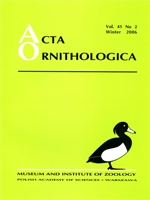Data are presented for the first time on the abundance and breeding ecology of the Brown Accentor in Lhasa, Tibet. During the non-breeding periods, the accentors occurred across a wide altitudinal gradient in a variety of habitats and remained numerically abundant. When breeding, they were restricted to alpine zones (> 4300 m) with scattered shrubs, and the population density declined to a low level (0.02 nests per ha). Nests were built partially in lone-standing short, thorny bushes and at a low height (< 0.8 m) above the ground. Dates of clutch initiation ranged from early May to mid-July, a period of 80 days. Clutch size varied between 2 and 3 eggs, averaging 2.9 (± 0.1). Eggs hatched after 13–14 days of incubation, and young birds fledged at 13–17 days, when they reached 97% of the adult weight. In terms of the proportion of clutches from which at least one chick fledged, breeding success was 56.3%. No evidence of multiple mating was found in this species.
How to translate text using browser tools
1 December 2006
Abundance and Breeding Ecology of Brown Accentors Prunella fulvescens in Lhasa, Tibet
Xin Lu
S. Ali
,
S. D. Ripley
1987. Handbook of the birds of India and Pakistan. Oxford Univ. Press. Google Scholar
A. V. Badyaev
1997. Avian life history variation along altitudinal gradients: An example with cardueline finches. Oecologia 111: 365–374. Google Scholar
A. V. Badyaev
,
C. K. Ghalambor
2001. Evolution of life histories along elevational gradients: Tradeoff between parental care and fecundity. Ecology 82: 2948–2960. Google Scholar
C. J. Bibby
,
N. D. Burgess
,
D. A. Hill
1992. Bird census techniques. Academic Press, London. Google Scholar
G. Bishton
2001. Social structure, habitat use and breeding biology of hedgerow Dunnocks Prunella modularis.
Bird Study 48: 188–193. Google Scholar
N. B. Davies
1985. Cooperation and conflict among dunnocks, Prunella modularis, in a variable mating system. Anim. Behav. 33: 628–648. Google Scholar
N. B. Davies
1986. Reproductive success of dunnocks, Prunella modularis, in a variable mating system. I. Factors influencing provisioning rate, nestling weight and fledging success. J. Anim. Ecol. 55: 123–138. Google Scholar
N. B. Davies
,
I. R. Hartley
,
B. J. Hatchwell
,
A. Desrochers
,
J. Skeer
,
D. Nebel
1995. The polygynandrous mating system of the alpine accentor, Prunella collaris. I. Ecological causes and reproductive conflicts. Anim. Behav. 49: 769–788. Google Scholar
N. B. Davies
,
B. J. Hatchwell
1992. The value of male parental care and its influence on reproductive allocation by male and female dunnocks. J. Anim. Ecol. 61: 259–272. Google Scholar
N. B. Davies
,
A. Lundberg
1984. Food distribution and a variable mating system in the dunnock, Prunella modularis.
J. Anim. Ecol. 53: 895–912. Google Scholar
R. Grimmentt
,
C. Inskipp
,
T. Inskipp
1998. Birds of the Indian Subcontinent. Christopher Helm, London. Google Scholar
I. R. Hartley
,
N. B. Davies
,
B. J. Hatchwell
,
A. Desrochers
,
D. Nebel
,
T. Burke
1995. The polygynandrous mating system of the alpine accentor, Prunella collaris. II. Multiple paternity and parental effort. Anim. Behav. 49: 789–803. Google Scholar
L. Heer
1994. Cooperative breeding, territoriality and parental care in the alpine accentor. J. Ornithol. 135: 109. Google Scholar
L. Heer
1996. Cooperative breeding by Alpine accentors Prunella collaris: polygynandry, territoriality and multiple paternity. J. Ornithol. 137: 35–51. Google Scholar
Y. X. Jiang
,
Z. L. Bi
,
Y. H. Sun
2002. Breeding notes on maroon-backed accentor Prunella immaculata in lianhuashan nature reserve. Sichuan J. Zool. 21: 94–95. Google Scholar
Y. X. Jiang
,
Y. H. Sun
,
Z. L. Bi
,
J. N. Song
2003. Description of the nest and eggs of maroon-backed accentor. Sichuan J. Zool. 22: 91–92. Google Scholar
X. Lu
2005. Reproductive ecology of blackbirds (Turdus merula maximus) in a high-altitude location, Tibet. J. Ornithol. 146: 72–78. Google Scholar
M. Nakamura
1990. Cloacal protuberance and copulatory behavior of the alpine accentor (Prunella collaris). Auk 107: 284–295. Google Scholar
M. Nakamura
1995a. Effects of supplemental feeding and female age on timing of breeding in the alpine accentor Prunella collaris.
Ibis 137: 56–63. Google Scholar
M. Nakamura
1995b. Effects of supplemental feeding and female age on reproductive success in the alpine accentor Prunella collaris.
J. Yamashina Inst. Ornithol. 27: 1–11. Google Scholar
M. Nakamura
1998a. Multiple mating and cooperative breeding in polygynandrous alpine accentors. I. Competition among females. Anim. Behav. 55: 259–275. Google Scholar
M. Nakamura
1998b. Multiple mating and cooperative breeding in polygynandrous alpine accentors. II. Male mating tactics. Anim. Behav. 55: 277–289. Google Scholar
X. A. Zhang
1982. Studies on breeding biology of 10 species of passerine birds in alpine meadow, northern Qinghai, China. Acta Zool. Sin. 28: 190–199. Google Scholar
G. M. Zheng
2002. A Checklist on the classification and distribution of the birds of the World. Science Press, Beijing. Google Scholar
Z. X. Zheng
,
D. H. Li
,
Z. X. Wang
,
Z. Y. Wang
,
Z. H. Jiang
,
T. C. Lu
1983. The avifauna of Tibet. Science Press, Beijing. Google Scholar

Acta Ornithologica
Vol. 41 • No. 2
December 2006
Vol. 41 • No. 2
December 2006
abundance
breeding biology
Brown Accentor
habitat selection
nestling diet
nest-site selection
Prunella fulvescens




